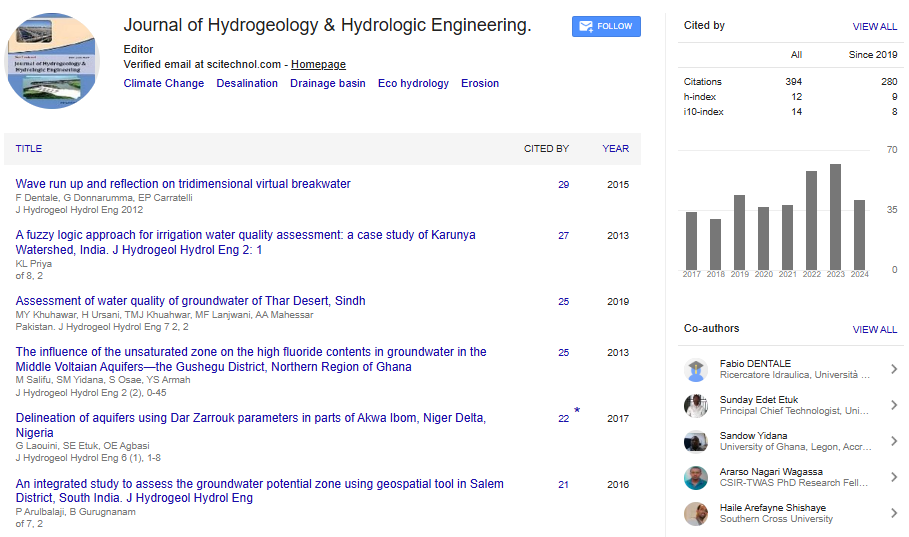Perspective, J Hydrogeol Hydrol Eng Vol: 13 Issue: 5
Innovative Methods for Treating Water and Wastewater: Improving Efficiency and Sustainability
Sarah Lee*
1Department of Water Resources Management, King Saud University, Riyadh, Saudi Arabia
*Corresponding Author: Sarah Lee,
Department of Water Resources Management,
King Saud University, Riyadh, Saudi Arabia
E-mail: leesarah38@gmail.com
Received date: 23 September, 2024, Manuscript No. JHHE-24-153107;
Editor assigned date: 25 September, 2024, PreQC No. JHHE-24-153107 (PQ);
Reviewed date: 09 October, 2024, QC No. JHHE-24-153107;
Revised date: 16 October, 2024, Manuscript No. JHHE-24-153107 (R);
Published date: 24 October, 2024, DOI: 10.4172/2325-9647.1000343
Citation: Lee S (2024) Innovative Methods for Treating Water and Wastewater: Improving Efficiency and Sustainability. J Hydrogeol Hydrol Eng 13:5.
Description
Water and wastewater treatment are essential processes that provide clean drinking water and maintain ecological health by treating and safely returning wastewater to the environment. With rising population growth, industrialization and environmental challenges, the demand for sustainable and efficient water treatment methods has never been more precarious. This article explores some innovative approaches in water and wastewater treatment, addressing the environmental and economic benefits these technologies bring to communities worldwide.
Clean water is essential for drinking, agriculture, sanitation and industrial processes. The absence of proper wastewater treatment leads to environmental degradation, public health risks and a depletion of clean water sources. Traditional methods of water and wastewater treatment, while effective, often rely heavily on chemicals and energyintensive processes, raising concerns about environmental sustainability. Modern, innovative approaches focus on reducing chemical usage, energy consumption and waste production, aiming for an eco-friendly treatment cycle that conserves resources and minimizes environmental impacts.
Membrane filtration has become a breakthrough technology in water treatment, particularly in desalination and purification. Techniques like reverse osmosis, nanofiltration and ultrafiltration use semi-permeable membranes to separate contaminants, salts and microorganisms from water. Membrane technology is highly effective in removing dissolved solids and pathogens, making it ideal for producing potable water. Additionally, it is more energy-efficient than traditional distillation methods used in desalination, contributing to a lower carbon footprint and reduced operational costs.
Advanced Oxidation Processes (AOPs) are highly effective for removing organic pollutants, pharmaceuticals and industrial chemicals that are often resistant to conventional treatment. By generating powerful oxidizing agents like hydroxyl radicals, AOPs degrade pollutants into harmless byproducts, enhancing the quality of treated water. Some AOP methods integrate Ultraviolet (UV) radiation and ozone, offering an energy-efficient and low-waste solution to remove contaminants without producing harmful byproducts. These methods have shown potential in treating water used in agriculture, industry and even municipal supplies, addressing complex contamination challenges.
Biofiltration and constructed wetlands harness natural biological processes to treat water and wastewater. Microorganisms and plants in these systems break down contaminants, reducing the need for chemical treatment and energy inputs. Constructed wetlands can effectively remove nutrients, organic matter and heavy metals, making them a sustainable choice for treating stormwater runoff, industrial wastewater and sewage. They also serve as biodiversity hotspots, supporting plant and animal life while filtering water naturally.
Electrodialysis (ED) and Electrodeionization (EDI) are techniques used for desalination and removing ions from water. These processes apply an electric current to separate dissolved ions through selective membranes. ED and EDI are particularly effective in producing highpurity water for medical and industrial applications, including pharmaceuticals and electronics manufacturing. Since they consume less energy than conventional desalination techniques, these methods contribute to lower operational costs and environmental impact, especially in areas where saltwater and brackish water are primary water sources.
Anaerobic digestion processes break down organic matter in wastewater without oxygen, producing biogas (mainly methane) as a byproduct. This biogas can be captured and used as a renewable energy source to power treatment facilities or even neighboring communities, making the process economically viable and environmentally beneficial. Anaerobic digestion reduces sludge volume, minimizes greenhouse gas emissions and produces nutrientrich effluents suitable for agricultural use, thereby closing the loop on waste and resource recovery.
Phosphorus and nitrogen are key nutrients in wastewater that, if not properly managed, can lead to environmental problems such as algal blooms in rivers and lakes. Recent innovations in nutrient recovery capture phosphorus and nitrogen from wastewater and convert them into fertilizers. This approach not only addresses pollution but also reduces dependency on synthetic fertilizers, promoting a circular economy in agricultural and wastewater treatment sectors.
Microbial Fuel Cells (MFCs) represent a promising technology for simultaneous wastewater treatment and energy generation. MFCs utilize bacteria that consume organic material in wastewater, generating a small amount of electricity. This approach is still in experimental stages but has the potential to revolutionize the energy footprint of wastewater treatment plants by partially offsetting their energy requirements through on-site electricity generation.
Innovative technologies in water and wastewater treatment are reshaping the landscape of water management. As these approaches become more widely adopted, communities will benefit from reduced environmental impact, improved public health and cost savings. Emphasizing energy efficiency, resource recovery and environmental responsibility in water treatment processes aligns with global sustainability goals, supporting both ecological conservation and the well-being of future generations.
 Spanish
Spanish  Chinese
Chinese  Russian
Russian  German
German  French
French  Japanese
Japanese  Portuguese
Portuguese  Hindi
Hindi 
